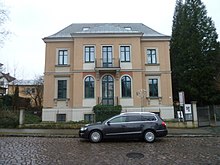Art exhibition cool
The art exhibition Kühl was founded by Heinrich Kühl in Dresden in 1924 and is now in the third generation as a family business. Alongside the Arnold Gallery , the Emil Richter Art Salon and the Neue Kunst Fides Gallery , it quickly established itself as an important forum for modern art with a focus on Dresden art. During this time, works by artists such as Christoph Voll , Karl Hofer , Paul Wilhelm , Josef Hegenbarth , Otto Dix , the painters of the bridge , Hans Hartung , Hermann Glöckner , El Lissitzky , Piet Mondrian and László Moholy-Nagy were shown .
Heinrich Kühl was able to partially evade the repression of the Nazi state by operating a one-storey gallery. Throughout the Nazi years, many works by artists no longer tolerated in the official art world, such as Hans Theo Richter and Curt Querner, were shown . During this time, harmless Asian art was also offered. However, works by Emil Nolde , Otto Dix , Paul Klee and prints by Wassily Kandinsky , Lyonel Feininger and Marc Chagall continued to be sold in secret.
history
Heinrich Kühl, born in Hanover in 1886 , completed an apprenticeship as a bookseller and after stays in Hamburg and England worked from 1911 as a manager at the Dresden gallery Arnold. In 1924 Heinrich Kühl went into business for himself and opened the art exhibition Kühl in the former Hotel Kaiserhof on Neustädter Markt at the foot of the Friedrich-August-Brücke . The gallery had three exhibition rooms on the mezzanine floor. After 1933, the premises were increasingly taken over by NSDAP offices and disputes broke out over the exhibits, which were perceived as provocative. In 1936 the art exhibition in Kühl moved to the old town at Kleine Brüdergasse 21 on the second floor.
The exhibition continued throughout the war. Art that was classified as degenerate was also sold on the sidelines. During the air raids on Dresden on February 13, 1945, the Kühl art dealership was destroyed. The current exhibition with the almost complete early work of Ernst Hassebrauk also burned down .
Shortly after the war, in 1945, Heinrich Kühl resumed exhibition activities on the first floor of the new location at Zittauer Strasse 12 in the Radeberger Vorstadt . From 1946 exhibitions were shown again on a regular basis. For a long time, the Kühl art exhibition was one of the few opportunities to exhibit in Dresden. Once again, mainly Dresden artists were presented. However, artists with abstract tendencies such as Ernst Wilhelm Nay and Karl Otto Götz were also shown .
In 1965 the son Johannes Kühl took over the management of the gallery. Johannes Kühl studied under Rudolf Schramm-Zittau at the Dresden Art Academy . His early works show a tendency towards impressionistic painting style. Johannes Kühl was drafted into World War II and returned from French captivity in 1946. He and his father had been running the Kühl art dealership since 1946.
A well-balanced mixture of older and newer works was also shown. With a lot of personal dedication and skill, Johannes Kühl managed to maintain his exhibition offerings, which were suspected by the authorities and deviated from the official course of socialist realism , and saved the gallery from being closed by the state. John cooling led the gallery also successful on the Turning Point from 1989 to the year 1994th
Since 1994, the Kunsthandlung Kühl has been run in the third generation by Sophia-Therese Schmidt-Kühl (* 1961). In 1999 the Kunsthandlung Kühl moved to new premises at Nordstrasse 5. Exhibitions continue to take place on a regular basis.
literature
- Peter Nüske: The art exhibition Kühl. Johannes Kühl in conversation with Peter Nüske . In: Eckhart Gillen and Rainer Haarmann (eds.): Art in the GDR . Kiepenheuer and Witsch, Cologne 1990, ISBN 3-462-02068-4 , p. 331-334 .
- Hans Peter Thurn : State Commerce or Exhibition Art ?. Self-assertion in the surveillance state . In: The art dealer. Changes in a profession . Hirmer, Munich 1994, ISBN 3-7774-6360-4 , p. 219-239 .
- Yvonne Fiedler: Art in the corridor: private galleries in the GDR between autonomy and illegality . Links, Berlin 2013, ISBN 978-3-86153-726-7 (also dissertation at the University of Leipzig, 2012).
Individual evidence
- ^ Dieter Hoffmann : Art in Dresden - The beginnings after 1945 . In: Günter Feist u. a. (Ed.): Art Documentation SBZ, GDR: 1945–1990 . DuMont, Cologne 1996, ISBN 3-7701-3846-5 , pp. 252-261 .
- ^ Hans Peter Thurn: State Commerce or Trade Fair Art ?. Self-assertion in the surveillance state . In: The art dealer. Changes in a profession . Hirmer, Munich 1994, ISBN 3-7774-6360-4 , p. 222 .
Web links
- Art exhibition cool. Internet presence.
Coordinates: 51 ° 4 ′ 2.7 ″ N , 13 ° 46 ′ 5.3 ″ E

